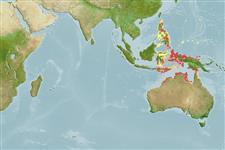Common names from other countries
Classification / Names / Names
Nomi Comuni | Sinonimi | Catalog of Fishes (gen., sp.) | ITIS | CoL | WoRMS
Environment: milieu / climate zone / depth range / distribution range
Ecologia
; acqua dolce; salmastro; distribuzione batimetrica 0 - 2 m (Ref. 97531). Tropical; 21°N - 18°S, 116°E - 151°E (Ref. 110598)
Indo-Pacific: M. rosenbergii actually are two separate species; M. rosenbergii is distributed East of Huxley's Line from the Philippines (including Palawan), Lesser Sunda Islands, New Guinea and northern Australia and M. dacqueti ranges from Pakistan, India, Sri Lanka to the Asian mainland in southern China, Taiwan and up to Malaysia, Borneo and Java.
Length at first maturity / Size / Peso / Age
Maturity: Lm ? range ? - ? cm Max length : 34.0 cm TL maschio/sesso non determinato; (Ref. 104052); 26 cm TL (female)
Wild post larvae migrate to down-stream near to the sea to a higher elevation freshwater waters streams (Ref. 82055). The native range of Macrobrachium rosenbergii actually consists of two separate species differing in adult morphological features. The actual M. rosenbergii occurs in northern Australia, Papua New Guinea, eastern Indonesia (east of Huxley's line including Bali) and the Philippines (includes Palawan). The second species is discovered as M. dacqueti (Sunier, 1925) which is actually the species extensively commercially fished and cultured. This species occurs in Asian mainland from Pakistan, India, Sri Lanka and southern China and to the western border of Huxley's line excluding Palawan, up to Borneo and Java (Ref. 110598, 110593). Coastal freshwater and estuarine (Ref. 97531), found in a mangrove (Ref. 121467). Survival rate and growth high at 0-15 ppt (Ref. 111574).
Life cycle and mating behavior
Maturità | Riproduzione | Deposizione | Uova | Fecundity | Larve
Members of the order Decapoda are mostly gonochoric. Mating behavior: Precopulatory courtship ritual is common (through olfactory and tactile cues); usually indirect sperm transfer.
del Mundo, C.M. 2000. (Ref. 10)
IUCN Red List Status (Ref. 130435)
CITES status (Ref. 108899)
Not Evaluated
Not Evaluated
Human uses
Pesca: commerciale
FAO - Acquacoltura: production, species profile; pesca: landings, species profile | FishSource | Sea Around Us
Strumenti
Fonti Internet
Estimates based on models
Preferred temperature
(Ref.
115969): 26.7 - 29.3, mean 28.7 (based on 1400 cells).
